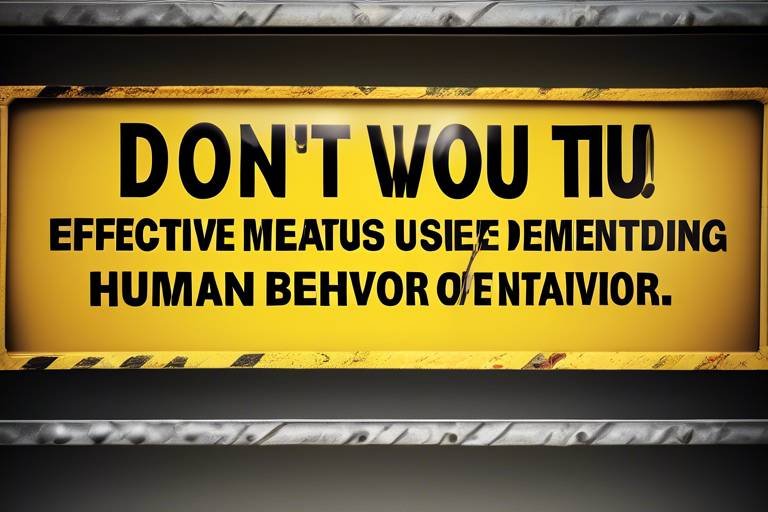Human Behavior Implications on Safety Policies
In today's fast-paced world, the effectiveness of safety policies is often put to the test by the unpredictable nature of human behavior. It's fascinating to think about how our actions, decisions, and even our emotions can shape the safety protocols designed to protect us. Have you ever wondered why some people strictly adhere to safety regulations while others seem to ignore them completely? This article delves into the intricate relationship between human behavior and safety policies, emphasizing the need to understand psychological factors to enhance compliance and reduce risks.
At the heart of this exploration lies the recognition that safety policies are not just rules; they are frameworks that depend heavily on how individuals perceive and respond to them. For instance, when a workplace implements a new safety measure, the way employees react can vary widely based on their past experiences, social influences, and even cognitive biases. It's not merely about having the right policies in place; it’s about ensuring that people are motivated to follow them. This understanding is crucial for organizations aiming to foster a culture of safety.
Moreover, as we navigate through various environments—be it industrial settings, offices, or public spaces—the implications of human behavior on safety policies become even more pronounced. The effectiveness of these policies can be significantly enhanced when we consider factors such as motivation, perception, and social dynamics. By addressing these aspects, organizations can create a more robust safety culture that not only protects individuals but also promotes overall well-being.
In the sections that follow, we will explore how understanding human behavior can lead to more effective safety policies. We will examine the role of perception, the impact of motivation, and the importance of behavioral interventions. By the end of this article, you will gain insights into how to tailor safety policies that resonate with individuals on a personal level, ultimately leading to better compliance and a safer environment for all.
- Why is understanding human behavior important for safety policies? Understanding human behavior is crucial because it influences how individuals perceive and comply with safety regulations, ultimately affecting the overall effectiveness of these policies.
- What role does motivation play in safety compliance? Motivation, both intrinsic and extrinsic, drives individuals to adhere to safety practices. Organizations can enhance compliance by fostering a motivating environment.
- How can organizations improve safety compliance? Organizations can improve compliance through targeted training programs, effective feedback mechanisms, and by addressing cognitive biases that may hinder safety practices.

Understanding Human Behavior
When we delve into the intricate world of human behavior, it's like peeling back the layers of an onion—each layer revealing something more complex and nuanced than the last. At the heart of this exploration lies the understanding that our actions are not merely reactions to external stimuli; they are deeply influenced by a myriad of psychological factors. Think about it: why do some people strictly adhere to safety policies while others seem to disregard them entirely? The answer often lies in the interplay of motivation, perception, and social influences.
One of the most striking aspects of human behavior is how motivation acts as a driving force behind compliance with safety regulations. Individuals are motivated by different factors—some may be driven by a genuine desire to keep themselves and others safe, while others might comply due to external pressures or the fear of penalties. Understanding these motivators is crucial for organizations looking to enhance compliance rates.
However, motivation alone doesn't tell the whole story. Our perception of safety policies plays a pivotal role in how we respond to them. For instance, if a worker perceives a safety rule as unnecessary or overly burdensome, they may be less likely to follow it. This perception can be shaped by a variety of factors, including previous experiences, the clarity of the policy, and the communication style used by management. For example, if a safety policy is communicated as a strict regulation rather than a guideline aimed at protecting individuals, it may breed resentment rather than compliance.
Moreover, social influences can significantly alter our perceptions and behaviors regarding safety. Humans are inherently social beings, and we often look to our peers for cues on how to behave. If a group of employees collectively downplays the importance of a safety measure, individual members may feel pressured to conform to that norm, regardless of their personal beliefs about safety. This phenomenon highlights the importance of fostering a positive safety culture within organizations, where adherence to safety policies is not only encouraged but celebrated.
In the end, understanding human behavior in the context of safety policies is not just about analyzing individual actions; it's about recognizing the broader social and psychological dynamics at play. By addressing these factors, organizations can create an environment that promotes compliance and minimizes risks. As we continue to explore the various dimensions of human behavior, it becomes clear that enhancing safety is not just a matter of implementing rules—it's about understanding the people behind those rules.

The Role of Perception in Safety
When it comes to safety, perception is everything. It’s the lens through which individuals interpret safety policies and regulations. Imagine a world where everyone sees safety measures as unnecessary or overly cautious—chaos would ensue, right? That's why understanding how perception shapes attitudes and behaviors is crucial for effective safety policy implementation. Perception is not just about how we see things; it’s deeply intertwined with our experiences, beliefs, and social influences. In this section, we will dive into how individual and collective perceptions can significantly impact compliance with safety regulations.
To illustrate the importance of perception, consider this: two employees might be working in the same environment with identical safety policies. However, if one perceives the risks as high and the other as minimal, their adherence to safety protocols will likely differ. This discrepancy can lead to dangerous situations. Why does this happen? It boils down to the subjective nature of perception. Each person carries a unique set of experiences and biases that shape how they view risks and safety measures.
Risk perception plays a pivotal role in decision-making processes related to safety. It’s fascinating how individuals assess risks based on their backgrounds, knowledge, and emotional responses. For instance, someone who has previously experienced a workplace accident may view safety protocols as absolutely essential, while another person who has never encountered such an event might dismiss them as overly cautious. This difference in risk perception can lead to varied adherence to safety protocols.
Research shows that individuals often rely on heuristics—mental shortcuts that simplify decision-making. These heuristics can sometimes skew their understanding of actual risks. For example, if someone hears about a serious accident in the news, they may overestimate the likelihood of such an event occurring in their own workplace. This is where the impact of media and personal experiences come into play, shaping perceptions that can either enhance or undermine compliance with safety measures.
Past experiences are powerful influencers of risk perception. If someone has witnessed or been involved in a safety incident, their subsequent behavior is likely to be affected. They may become more vigilant and compliant with safety measures, driven by a desire to avoid repeating a negative experience. On the flip side, individuals who have never faced such situations may not feel the same urgency to adhere to safety protocols. This variance highlights the need for organizations to understand their workforce's history and tailor safety training accordingly.
Social dynamics play a critical role in shaping individual perceptions of safety. Peer influence and group norms can significantly affect how safety policies are viewed and followed. For instance, if a group of employees collectively disregards a safety rule, an individual may feel pressured to conform, even if they recognize the importance of that rule. Have you ever felt the urge to follow the crowd? This phenomenon illustrates how powerful social validation can be in determining behavior.
Organizations can leverage this understanding by fostering a culture of safety where positive behaviors are celebrated and reinforced. By creating an environment where safety is a shared value, companies can enhance compliance rates. This could involve regular team discussions about safety practices, encouraging open communication about risks, and recognizing individuals who consistently adhere to safety protocols.
In summary, perception is a critical component in the realm of safety. Understanding how individuals and groups perceive risks can lead to more effective safety policies and greater compliance. By addressing the psychological factors that influence perception, organizations can create a safer working environment for everyone.
- How does perception affect safety compliance?
Perception influences how individuals view risks and safety measures, impacting their likelihood of adhering to safety protocols. - What role do past experiences play in safety behavior?
Past experiences can heighten awareness and compliance with safety measures, especially if individuals have encountered safety incidents before. - How can organizations improve safety perceptions?
Organizations can improve safety perceptions by fostering a culture of safety, encouraging open communication, and recognizing positive safety behaviors.

Risk Perception
Risk perception is a fascinating and complex concept that plays a pivotal role in how individuals make decisions regarding their safety. When we talk about risk, we're not just discussing the statistical likelihood of an accident occurring; we're delving into how people interpret and react to potential dangers in their environment. This perception is influenced by a multitude of factors, including personal experiences, cultural background, and even the way information is presented to them.
For instance, consider two individuals faced with the same safety policy. One might view it as a necessary precaution, while the other may see it as an unnecessary restriction. This discrepancy often stems from how each person perceives risk. Some people have a heightened sensitivity to danger due to past experiences, while others may underestimate risks because they have never encountered a safety incident before. The way we perceive risk can significantly impact our behavior and compliance with safety protocols.
To further illustrate this, let’s look at some common factors that can shape risk perception:
- Personal Experience: Individuals who have previously experienced an accident or near-miss are likely to have a heightened sense of risk. Their past encounters can lead to more cautious behavior in similar situations.
- Social Influence: The opinions and behaviors of peers can dramatically shape an individual’s perception of risk. If a person’s social circle dismisses certain safety measures, they may feel pressured to conform, potentially endangering themselves.
- Media Representation: The way risks are portrayed in the media can skew public perception. For example, sensationalized news stories about accidents can lead to an inflated sense of danger, causing individuals to overreact.
Moreover, cognitive biases also play a significant role in how we perceive risk. For instance, the optimism bias leads many to believe that they are less likely to experience negative events compared to others. This can result in a false sense of security, causing individuals to neglect safety protocols. On the other hand, the availability heuristic can cause people to overestimate risks based on recent events they’ve heard about, even if those events are statistically rare.
Understanding these nuances in risk perception is essential for developing effective safety policies. Organizations need to consider how their employees perceive risks and tailor their communication strategies accordingly. By addressing the psychological factors that influence risk perception, companies can foster a culture of safety that encourages compliance and reduces the likelihood of accidents.
- What is risk perception? Risk perception refers to the subjective judgment that individuals make regarding the characteristics and severity of a risk. It encompasses how people interpret and respond to potential dangers.
- How does personal experience influence risk perception? Personal experiences, especially negative ones, can heighten an individual’s sensitivity to risks, making them more cautious in similar situations in the future.
- Can social influences affect how we perceive risks? Absolutely! The behaviors and attitudes of peers can significantly shape an individual's perception of risk, often leading to conformity in safety practices.

The Influence of Past Experiences
When it comes to safety compliance, past experiences play a pivotal role in shaping how individuals perceive and respond to safety measures. Think about it: if someone has previously been involved in a safety incident, their outlook on safety protocols is likely to be significantly impacted. This phenomenon can be likened to a scar left by a wound; once an individual has experienced something traumatic, it tends to alter their behavior in the future. For instance, a worker who has witnessed a colleague suffer an injury due to negligence may be more vigilant and compliant with safety rules, driven by the fear of repetition.
Moreover, past experiences can create a feedback loop in decision-making. If an individual has successfully adhered to safety policies and avoided incidents, they are more likely to continue following those policies, reinforcing positive behavior. Conversely, if their past experiences include ignoring safety protocols without facing immediate consequences, they may develop a false sense of security, leading to risky behaviors. This highlights the importance of understanding how past experiences influence not only individual behaviors but also collective attitudes towards safety within organizations.
Consider the following factors that illustrate the impact of past experiences on safety compliance:
- Learning from Mistakes: Individuals often learn more from negative experiences than from positive ones. If someone has made a mistake that led to an accident, they are likely to internalize that lesson and become more cautious in the future.
- Vicarious Learning: Observing others' experiences can also shape behavior. If an employee sees a peer getting injured due to non-compliance, they might adjust their own behavior to avoid a similar fate.
- Emotional Responses: Past experiences can evoke strong emotional responses, such as fear or anxiety, which can further influence how individuals approach safety protocols. A person who has witnessed a serious accident may develop an acute awareness of risks and be more likely to adhere to safety guidelines.
In summary, the influence of past experiences on safety behavior is profound. Organizations must recognize that individuals come with their own histories that shape their perceptions and actions. By understanding these influences, companies can implement targeted interventions that address specific past experiences, ultimately fostering a culture of safety that resonates with employees on a personal level.
- How do past experiences affect an individual’s perception of safety?
Past experiences can create lasting impressions that shape how individuals view safety protocols. Positive experiences may encourage compliance, while negative experiences may instill fear and caution. - Can organizations influence the impact of past experiences on safety behavior?
Yes, organizations can implement training and awareness programs that address past incidents and promote a culture of learning from mistakes, thereby influencing future behavior. - What role does emotional response play in safety compliance?
Emotional responses to past experiences can significantly impact compliance. Fear or anxiety stemming from previous incidents may lead to heightened vigilance and adherence to safety measures.

Social Influences on Perception
The way we perceive safety is not solely a product of our individual experiences or knowledge; it is profoundly shaped by the social environments we inhabit. Think about it: when we are surrounded by others, our behaviors and attitudes often align with those around us. This phenomenon is known as social influence, and it plays a pivotal role in how we interpret and adhere to safety policies. For instance, if a group of colleagues consistently disregards a safety protocol, an individual may feel pressured to conform, even if they recognize the importance of that protocol. This creates a ripple effect where the collective behavior overshadows individual knowledge or beliefs about safety.
Moreover, social norms can dictate what is considered acceptable behavior in a given environment. When safety practices are perceived as commonplace or unimportant within a social group, compliance can wane. It’s similar to how trends spread through social media; if everyone is doing it, it becomes normalized, regardless of the underlying risks. To illustrate this, consider the following table that highlights how different social dynamics can influence compliance with safety policies:
| Social Dynamic | Impact on Safety Compliance |
|---|---|
| Peer Pressure | Can lead to increased risk-taking behaviors if safety measures are deemed unnecessary by the group. |
| Group Norms | Establish a baseline for acceptable behavior; if safety is not prioritized, individuals may feel justified in neglecting it. |
| Leadership Influence | Strong leadership can foster a culture of safety; leaders who prioritize safety encourage their teams to follow suit. |
| Organizational Culture | A culture that values safety will likely see higher compliance rates compared to one that does not. |
Another key aspect to consider is the role of communication within social groups. How safety information is conveyed can significantly affect perceptions. If safety guidelines are communicated through engaging and relatable formats—like group discussions or interactive workshops—individuals are more likely to internalize and act upon those guidelines. On the other hand, if the information is delivered in a dry, impersonal manner, it may not resonate with the audience, leading to apathy towards compliance.
Ultimately, understanding the social influences on perception is crucial for developing effective safety policies. By fostering an environment where safety is a shared value, organizations can enhance compliance and reduce risks. This involves not just establishing rules, but also cultivating a culture where safety is prioritized and discussed openly among peers. When individuals feel supported by their social circles, they are more likely to adhere to safety measures, creating a safer environment for everyone.
- How do social influences affect individual behavior regarding safety?
Social influences can lead individuals to conform to group norms, which may either enhance or undermine compliance with safety policies. - What role does communication play in shaping perceptions of safety?
Effective communication can enhance understanding and adherence to safety protocols, while poor communication can lead to misunderstanding and neglect. - How can organizations foster a culture of safety?
Organizations can promote safety by encouraging open discussions, providing training, and leading by example through strong leadership.

Cognitive Biases in Safety Compliance
Cognitive biases are mental shortcuts that can lead to irrational decision-making, especially when it comes to safety compliance. These biases often cloud our judgment and can result in dangerous oversights. For instance, when individuals underestimate risks due to optimism bias, they might think, "That won't happen to me," leading them to ignore safety protocols. This kind of thinking is not just naive; it's a significant barrier to maintaining a safe environment.
Another common cognitive bias is the availability heuristic. This occurs when people evaluate the likelihood of an event based on how easily they can recall instances of that event. If someone has witnessed a workplace accident recently, they may overestimate the chances of it happening again, potentially leading to excessive caution. Conversely, if they haven't experienced an incident in a long time, they might become complacent, believing that safety measures are unnecessary. This inconsistency in perception can create a fluctuating adherence to safety policies, which is detrimental to overall safety culture.
Moreover, the confirmation bias can exacerbate safety issues. This bias leads individuals to seek out information that supports their pre-existing beliefs while ignoring evidence that contradicts them. For example, if someone believes that safety gear is uncomfortable, they might only focus on stories or testimonials that reinforce that view, disregarding the overwhelming evidence that safety gear is essential for protection. This selective perception can undermine safety initiatives and create a culture where compliance is viewed as optional rather than mandatory.
To illustrate the impact of cognitive biases on safety compliance, consider the following table that outlines some common biases and their implications:
| Cognitive Bias | Description | Implication for Safety Compliance |
|---|---|---|
| Optimism Bias | Belief that negative events are less likely to happen to oneself. | May lead to ignoring safety measures. |
| Availability Heuristic | Judging the probability of an event based on recent memories. | Can cause inconsistent adherence to safety protocols. |
| Confirmation Bias | Seeking information that confirms existing beliefs. | May result in ignoring critical safety information. |
Understanding these cognitive biases is crucial for organizations aiming to improve safety compliance. By recognizing how these mental shortcuts influence behavior, safety managers can develop targeted interventions that address these biases. For example, training sessions that emphasize the importance of safety gear and provide evidence-based information can counteract the effects of confirmation bias.
In conclusion, cognitive biases play a significant role in shaping safety compliance behaviors. By fostering awareness and understanding of these biases, organizations can create a more robust safety culture where individuals recognize the importance of adhering to safety policies. This proactive approach not only enhances compliance but also ultimately leads to a safer working environment for everyone.
- What are cognitive biases? Cognitive biases are systematic patterns of deviation from norm or rationality in judgment, affecting the decisions and judgments that people make.
- How do cognitive biases affect safety compliance? They can lead to poor decision-making, where individuals might underestimate risks or ignore safety protocols based on their perceptions.
- What can organizations do to mitigate cognitive biases? Organizations can implement training programs that educate employees about cognitive biases and their impact on safety, as well as promote a culture of open communication regarding safety concerns.

Motivation and Compliance
Understanding what drives individuals to comply with safety policies is crucial for any organization aiming to create a safe environment. Motivation can be seen as the fuel that propels people toward adhering to regulations and protocols. It’s not just about having rules in place; it’s about igniting a sense of responsibility and urgency within individuals. Think of it this way: if compliance is a car, motivation is the engine that makes it go. Without a strong engine, the car may sit idle, no matter how polished the exterior looks.
There are two primary types of motivation that play a significant role in compliance: intrinsic and extrinsic. Intrinsic motivation stems from personal values and beliefs. When individuals feel a personal connection to the importance of safety, they are more likely to engage in safe behaviors. For example, someone who has a family member affected by a workplace accident may develop a strong intrinsic motivation to adhere to safety protocols, not just for themselves but also for the sake of their loved ones. This emotional connection can lead to a profound commitment to safety practices.
On the other hand, extrinsic motivation involves external factors that influence behavior. These can include rewards for compliance or penalties for violations. Organizations can implement various strategies to enhance extrinsic motivation. For instance, a company might offer bonuses for teams that maintain a record of zero accidents over a quarter. This creates a tangible incentive for employees to prioritize safety. Additionally, penalties for non-compliance can serve as a deterrent, reminding individuals of the potential consequences of unsafe behaviors.
To illustrate the balance between intrinsic and extrinsic motivation, consider the following table:
| Type of Motivation | Description | Examples |
|---|---|---|
| Intrinsic | Motivation driven by internal rewards and personal values. | Belief in the importance of safety, personal responsibility, emotional connections. |
| Extrinsic | Motivation influenced by external rewards or penalties. | Bonuses for compliance, penalties for violations, recognition programs. |
Both types of motivation are essential for fostering a culture of safety. Organizations need to create an environment where intrinsic motivation can flourish while also implementing effective extrinsic strategies. This dual approach not only enhances compliance but also ensures that individuals feel valued and recognized for their efforts. After all, when people feel appreciated, they are more likely to invest in their roles and take safety seriously.
Ultimately, motivating individuals to comply with safety policies is about understanding their needs and values. By tapping into both intrinsic and extrinsic motivators, organizations can cultivate a culture where safety is not just a set of rules to follow, but a shared commitment among all employees. This shared commitment transforms safety from a mere obligation into a collective value, where everyone plays a part in ensuring a safe workplace.
- What is the difference between intrinsic and extrinsic motivation?
Intrinsic motivation comes from within the individual, driven by personal values and beliefs, while extrinsic motivation is influenced by external rewards or penalties. - How can organizations promote intrinsic motivation for safety compliance?
Organizations can promote intrinsic motivation by fostering a culture of safety, providing education about the importance of safety, and encouraging personal connections to safety practices. - What are some effective extrinsic motivation strategies?
Effective strategies include implementing reward systems for compliance, recognizing safe behaviors publicly, and establishing clear penalties for violations.

Intrinsic Motivation Factors
When we think about what drives people to comply with safety policies, it's essential to consider the at play. These factors are deeply rooted in our personal values, beliefs, and the inherent satisfaction we gain from doing things that align with our principles. Imagine a workplace where every employee feels a sense of responsibility not just for their own safety but also for their colleagues. This sense of duty can significantly enhance adherence to safety protocols.
One of the key aspects of intrinsic motivation is the concept of personal values. For instance, someone who values teamwork is likely to prioritize safety measures that protect not just themselves but also their teammates. This intrinsic drive to look out for others can lead to a more robust safety culture within an organization. Additionally, when individuals feel a personal connection to the safety policies—perhaps because they have witnessed a near-miss incident or have been affected by a workplace accident—they are more likely to internalize these policies and act on them.
Furthermore, self-efficacy plays a critical role in intrinsic motivation. This term refers to an individual’s belief in their ability to execute tasks and achieve goals. When employees feel competent in their understanding of safety protocols, they are more inclined to follow them. Organizations can foster this by providing comprehensive training that not only informs but empowers employees. For example, a well-structured training program can enhance self-efficacy by allowing employees to practice safety procedures in a controlled environment, thus building their confidence.
Another intrinsic motivator is the pursuit of personal growth. Many individuals are driven by the desire to improve themselves and develop new skills. In the context of safety compliance, this can manifest as a commitment to learning more about best practices, attending workshops, or seeking certifications. When organizations recognize and support this pursuit of growth, they create an environment where safety becomes a shared value, leading to a culture of compliance. Employees who are engaged in their personal development are more likely to take safety seriously, viewing it as an integral part of their professional journey.
In summary, intrinsic motivation factors such as personal values, self-efficacy, and the desire for personal growth are crucial in shaping how individuals approach safety policies. By understanding and nurturing these factors, organizations can create a more compliant and proactive workforce.
- What are intrinsic motivation factors?
Intrinsic motivation factors are internal drivers that influence individuals to engage in certain behaviors, such as personal values, beliefs, and the satisfaction derived from performing a task.
- How can organizations foster intrinsic motivation for safety compliance?
Organizations can foster intrinsic motivation by recognizing employees' personal values, enhancing their self-efficacy through training, and supporting their pursuit of personal growth.
- Why is self-efficacy important in safety compliance?
Self-efficacy is vital because it affects an individual’s confidence in their ability to follow safety protocols. Higher self-efficacy often leads to better compliance with safety measures.
- Can personal experiences influence safety behavior?
Absolutely! Personal experiences, particularly those related to safety incidents, can significantly shape an individual's perception of risk and their subsequent behavior in adhering to safety policies.

Extrinsic Motivation Strategies
When it comes to ensuring compliance with safety policies, extrinsic motivation strategies play a pivotal role. These strategies involve external factors that encourage individuals to follow safety regulations, often through tangible rewards or consequences. Think of it as a game where players are motivated by points, prizes, or even the fear of penalties. By leveraging extrinsic motivators, organizations can create an environment that not only promotes safety but also fosters a culture of accountability.
One effective strategy is the implementation of a reward system. This approach can include various incentives such as bonuses, recognition programs, or even small gifts for individuals or teams that consistently adhere to safety protocols. For example, a monthly award for the safest team can spark friendly competition and motivate employees to prioritize safety. The excitement of earning a reward can be a powerful motivator, transforming safety compliance from a mundane task into a sought-after achievement.
Moreover, organizations can utilize penalties as a form of extrinsic motivation. While the idea of punishment may sound harsh, it can be a necessary tool to emphasize the importance of safety. When employees understand that non-compliance could lead to disciplinary actions, they may be more inclined to follow safety guidelines. However, it’s crucial to strike a balance; the aim should be to encourage compliance rather than instill fear. A well-structured penalty system should be transparent and fair, ensuring that everyone understands the consequences of their actions.
Additionally, organizations can enhance extrinsic motivation by incorporating safety performance metrics into regular evaluations. This could be presented in a
| Employee Name | Compliance Rate (%) | Rewards Earned |
|---|---|---|
| John Doe | 95 | Gift Card |
| Jane Smith | 90 | Extra Day Off |
| Bob Johnson | 85 | Recognition Certificate |
Such transparency not only motivates individuals to improve their safety practices but also creates a sense of camaraderie among employees. When everyone is aware of their standing and the rewards available, it fosters a collective effort towards maintaining a safe work environment.
Lastly, regular communication about the importance of safety and the rewards associated with compliance cannot be overlooked. Organizations should actively promote their safety programs through meetings, newsletters, and even social media. This constant reminder reinforces the idea that safety is a priority and that there are tangible benefits to adhering to policies.
In summary, extrinsic motivation strategies are essential in promoting compliance with safety policies. By implementing reward systems, establishing fair penalties, utilizing performance metrics, and maintaining open communication, organizations can effectively enhance safety behaviors among their employees. It’s all about creating an environment where safety is not just a requirement, but a valued aspect of the workplace culture.
- What are extrinsic motivation strategies? Extrinsic motivation strategies are external factors, like rewards and penalties, that encourage compliance with safety policies.
- How can rewards improve safety compliance? Rewards can create a sense of achievement and motivate individuals to prioritize safety in their daily tasks.
- Are penalties effective in promoting safety? Yes, penalties can emphasize the importance of safety, but they should be used carefully to avoid creating a culture of fear.
- What role does communication play in extrinsic motivation? Regular communication about safety policies and associated rewards reinforces their importance and keeps employees engaged.

Behavioral Interventions for Safety
Implementing behavioral interventions is crucial for enhancing safety compliance within any organization. These interventions are designed to change behaviors by addressing the underlying psychological factors that influence how individuals respond to safety policies. Just like a gardener nurtures plants to help them grow, organizations must cultivate a culture of safety through tailored interventions that resonate with employees on a personal level.
One of the most effective strategies in this realm is the introduction of training and awareness programs. These initiatives serve to educate employees about safety regulations and the importance of compliance. Imagine walking into a room filled with employees, each equipped with the knowledge to recognize potential hazards and the skills to mitigate them. This scenario can become a reality through comprehensive training sessions that not only inform but also inspire. By utilizing interactive methods such as workshops, simulations, and real-life scenarios, organizations can foster a deeper understanding of safety practices, ultimately leading to a more compliant workforce.
Moreover, feedback mechanisms are another essential component of behavioral interventions. Providing constructive feedback to employees regarding their safety practices can significantly reinforce positive behavior. Think of feedback as a mirror reflecting one’s actions; it allows individuals to see how their behavior aligns with safety standards. Regular feedback sessions, whether through one-on-one meetings or team discussions, can create an open dialogue about safety practices. This interaction not only helps employees understand where they excel but also highlights areas for improvement, creating a continuous loop of learning and adaptation.
In addition to training and feedback, organizations can benefit from leveraging social influence as a behavioral intervention. When employees see their peers actively engaging in safe practices, they are more likely to follow suit. This phenomenon can be harnessed by establishing safety champions within teams—individuals who embody safety values and motivate others to do the same. By recognizing and rewarding these champions, organizations can create a ripple effect that encourages widespread compliance with safety policies.
To illustrate the impact of behavioral interventions, consider the following table that outlines various strategies and their anticipated effects on safety compliance:
| Intervention Strategy | Expected Outcome |
|---|---|
| Training and Awareness Programs | Increased knowledge and understanding of safety practices |
| Feedback Mechanisms | Reinforcement of positive safety behaviors |
| Peer Influence Initiatives | Enhanced motivation to comply with safety policies |
| Reward Systems | Increased adherence to safety protocols |
In conclusion, behavioral interventions for safety are not merely about enforcing rules; they are about creating an environment where safety becomes a shared value. By implementing training programs, providing feedback, and leveraging social influences, organizations can foster a culture of safety that resonates with every employee. Just as a strong foundation is vital for a sturdy building, a solid commitment to behavioral interventions lays the groundwork for a safer workplace.
- What are behavioral interventions? Behavioral interventions are strategies designed to change individuals' behaviors by addressing psychological factors that influence compliance with safety policies.
- Why are training programs important? Training programs educate employees about safety regulations, increasing their knowledge and motivation to adhere to safety practices.
- How does feedback improve safety compliance? Feedback provides employees with insights into their safety practices, reinforcing positive behaviors and highlighting areas for improvement.
- What role does peer influence play in safety? Peer influence can motivate individuals to comply with safety policies, especially when they see their colleagues actively engaging in safe practices.

Training and Awareness Programs
This article explores how human behavior influences the effectiveness of safety policies in various environments, emphasizing the importance of understanding psychological factors to enhance compliance and reduce risks.
Examining the fundamental aspects of human behavior provides insight into how individuals react to safety policies, highlighting the significance of motivation, perception, and social influences in compliance.
Perception significantly affects how safety policies are understood and followed. This section discusses how individual and collective perceptions shape attitudes towards safety regulations and practices.
Risk perception plays a crucial role in decision-making. This subsection explores how individuals assess risks and how these assessments impact their adherence to safety protocols.
Past experiences shape individuals' perceptions of risk. This part delves into how previous encounters with safety incidents can affect future behavior and compliance with safety measures.
Social dynamics can alter risk perception. This section discusses how peer influence and group norms can affect individual compliance with safety policies.
Cognitive biases can lead to flawed decision-making regarding safety. This subsection examines common biases that may hinder adherence to safety practices and policies.
Understanding what motivates individuals to comply with safety policies is essential. This section highlights intrinsic and extrinsic motivators that influence behavior in safety contexts.
Intrinsic motivation, such as personal values and beliefs, significantly impacts safety behavior. This part discusses how fostering intrinsic motivation can enhance compliance with safety standards.
Extrinsic motivators, like rewards and penalties, can effectively encourage compliance. This subsection explores various strategies organizations can implement to promote adherence to safety policies.
Implementing behavioral interventions can enhance safety compliance. This section discusses effective strategies and programs designed to modify behavior and improve adherence to safety policies.
Training and awareness initiatives are vital for promoting safety behaviors. These programs not only educate employees about the importance of safety but also empower them to take ownership of their actions. When individuals understand the rationale behind safety protocols, they are more likely to follow them. For example, a well-structured training program can include hands-on demonstrations, interactive sessions, and real-life scenarios that engage participants and make the learning process more impactful.
Moreover, awareness programs can be tailored to address specific safety concerns relevant to a particular workplace. By conducting regular workshops and refresher courses, organizations can keep safety at the forefront of employees' minds. This continuous education helps in reinforcing the significance of adhering to safety measures, creating a culture of safety.
To illustrate the effectiveness of training programs, consider the following table that outlines key components of successful training and awareness initiatives:
| Component | Description | Benefits |
|---|---|---|
| Hands-on Training | Practical exercises that simulate real-life scenarios. | Enhances skill retention and boosts confidence. |
| Interactive Workshops | Group discussions and activities that promote engagement. | Encourages teamwork and shared learning. |
| Regular Refresher Courses | Ongoing training sessions to update knowledge and skills. | Maintains awareness of safety protocols and techniques. |
Additionally, incorporating feedback mechanisms into training programs is essential. By providing participants with constructive feedback on their performance, organizations can help individuals identify areas for improvement, thereby enhancing overall compliance. This two-way communication fosters a supportive environment where employees feel valued and motivated to adhere to safety practices.
- What are the main goals of training and awareness programs?
Training and awareness programs aim to educate employees about safety protocols, enhance their skills, and foster a culture of safety within the organization. - How often should training sessions be conducted?
It is recommended to conduct training sessions regularly, with refresher courses at least once a year or more frequently based on the nature of the work and safety concerns. - Can training programs be customized?
Yes, training programs can and should be tailored to address specific safety issues relevant to the workplace and the employees' roles.

Feedback Mechanisms
Feedback mechanisms are essential components in fostering a culture of safety within organizations. They serve as the bridge between safety policies and employee behavior, ensuring that individuals are not only aware of safety protocols but are also engaging with them in a meaningful way. Imagine feedback as a compass; it guides individuals towards safer practices and helps them navigate the often complex landscape of workplace safety.
One of the most effective feedback mechanisms involves real-time feedback. This can take the form of immediate responses to safety practices observed on the job. For instance, if a supervisor notices an employee using a safety harness correctly, they can provide instant praise. This not only reinforces positive behavior but also boosts the employee's confidence in following safety measures. Conversely, if a safety violation occurs, addressing it promptly allows individuals to correct their actions before habits form. This immediacy is crucial in maintaining high safety standards.
Moreover, regular safety audits and assessments can serve as a structured feedback mechanism. These audits provide opportunities to evaluate compliance with safety policies and identify areas for improvement. Organizations can create a feedback loop where the results of these audits are communicated back to employees. This transparency helps individuals understand the impact of their actions and encourages a collective responsibility towards safety.
In addition to direct feedback, incorporating technology can significantly enhance feedback mechanisms. For example, many organizations are now utilizing safety apps that allow employees to report hazards or unsafe conditions in real-time. These platforms often include features for providing feedback on safety practices, enabling a two-way communication channel. This not only empowers employees but also creates a sense of ownership over their safety practices.
Furthermore, establishing a culture of open communication is vital. Employees should feel comfortable sharing their thoughts and experiences regarding safety without fear of retribution. When organizations actively seek feedback from their workforce, they can gain valuable insights into the effectiveness of their safety policies. To illustrate this, consider the following table that outlines various feedback mechanisms and their benefits:
| Feedback Mechanism | Benefits |
|---|---|
| Real-time Feedback | Reinforces positive behavior, corrects mistakes immediately |
| Safety Audits | Identifies compliance gaps, fosters accountability |
| Safety Apps | Encourages reporting of hazards, enables two-way communication |
| Open Communication | Gathers insights, builds trust within the team |
In conclusion, effective feedback mechanisms are not just about correcting unsafe behaviors; they are integral to building a proactive safety culture. By implementing these mechanisms, organizations can ensure that safety is not merely a set of rules but a shared value among all employees. With the right feedback in place, individuals are more likely to adhere to safety policies, leading to a safer working environment for everyone.
- What are feedback mechanisms? Feedback mechanisms are systems or processes that provide individuals with information about their performance, particularly regarding safety practices.
- Why are feedback mechanisms important for safety compliance? They help reinforce positive behaviors, correct unsafe practices quickly, and promote a culture of safety within organizations.
- How can technology enhance feedback mechanisms? Technology, such as safety apps, allows for real-time reporting and feedback, creating a more interactive and responsive safety culture.
- What role does open communication play in feedback mechanisms? Open communication encourages employees to share their experiences and insights, which can lead to improved safety protocols and a stronger safety culture.
Frequently Asked Questions
- What role does human behavior play in safety compliance?
Human behavior is at the core of safety compliance. It influences how individuals perceive risks and respond to safety policies. Understanding psychological factors such as motivation and perception is key to enhancing compliance and reducing risks.
- How does perception affect adherence to safety policies?
Perception significantly impacts how safety policies are understood. If individuals perceive a policy as unnecessary or overly complicated, they may disregard it. Collective attitudes towards safety regulations, shaped by social influences, also play a crucial role in compliance.
- What is risk perception and why is it important?
Risk perception refers to how individuals assess potential dangers. It's important because it directly influences decision-making. If someone underestimates a risk, they may fail to follow necessary safety protocols, leading to increased accidents or incidents.
- How do past experiences shape safety behavior?
Past experiences with safety incidents can significantly alter an individual's perception of risk. If someone has previously encountered a safety issue, they may become more cautious and compliant with safety measures in the future.
- What cognitive biases can affect safety compliance?
Cognitive biases, such as overconfidence or the optimism bias, can lead individuals to underestimate risks or ignore safety protocols. Recognizing these biases is essential for improving adherence to safety practices.
- What motivates individuals to comply with safety policies?
Motivation can be intrinsic, driven by personal values and beliefs, or extrinsic, influenced by rewards and penalties. Understanding these motivators helps organizations develop effective strategies to encourage compliance.
- How can organizations foster intrinsic motivation for safety?
Organizations can foster intrinsic motivation by aligning safety policies with employees' personal values and beliefs. Encouraging a culture of safety where individuals feel personally responsible for their own safety and that of others can enhance compliance.
- What are some effective extrinsic motivation strategies?
Extrinsic motivators can include reward systems for safe behavior or penalties for non-compliance. Implementing these strategies can create a more structured environment where individuals are encouraged to adhere to safety policies.
- How do behavioral interventions improve safety compliance?
Behavioral interventions, such as training and awareness programs, help modify behavior by educating individuals about safety practices. These programs increase knowledge and understanding, leading to better compliance with safety regulations.
- Why are feedback mechanisms important for safety?
Feedback mechanisms are crucial because they reinforce positive safety behaviors. Providing individuals with regular feedback about their safety practices helps them recognize areas for improvement and encourages ongoing compliance.



















